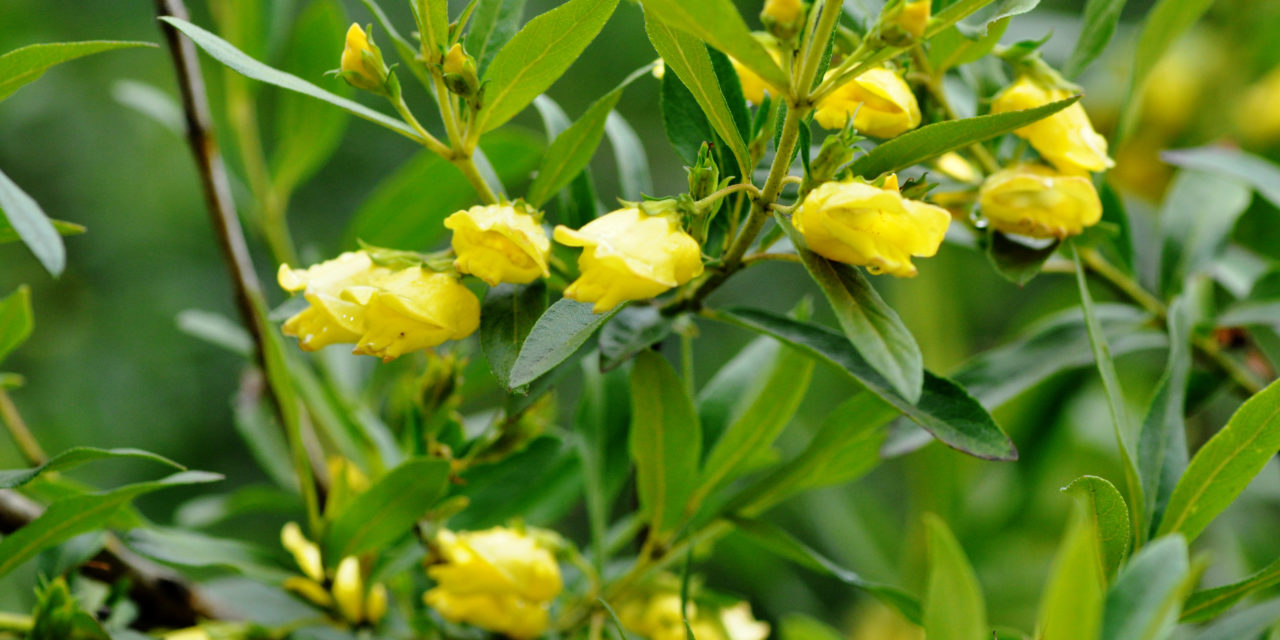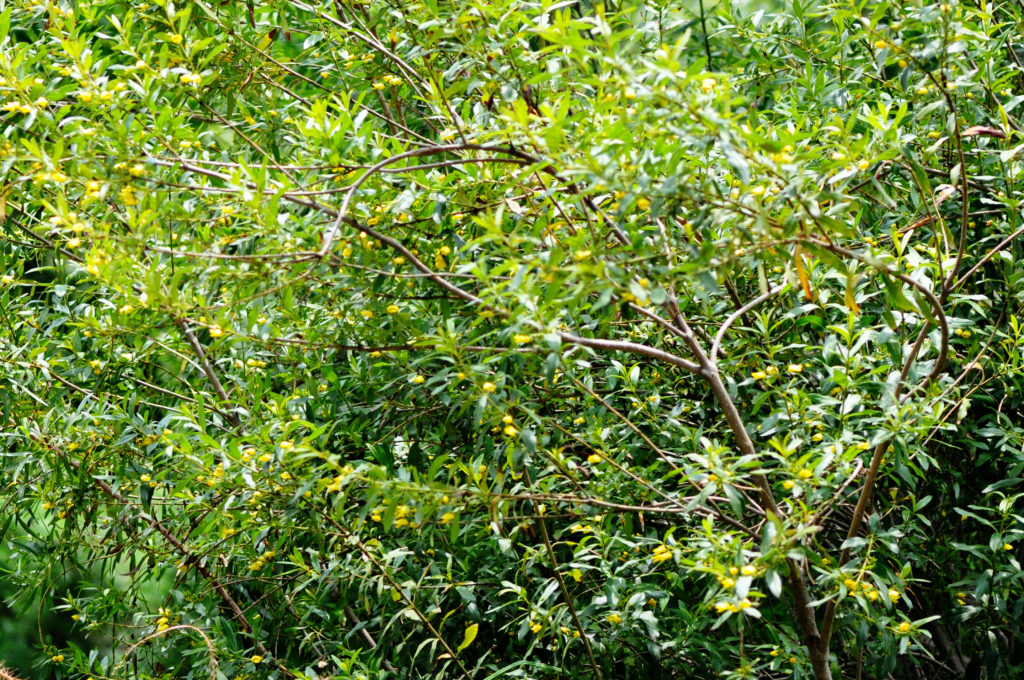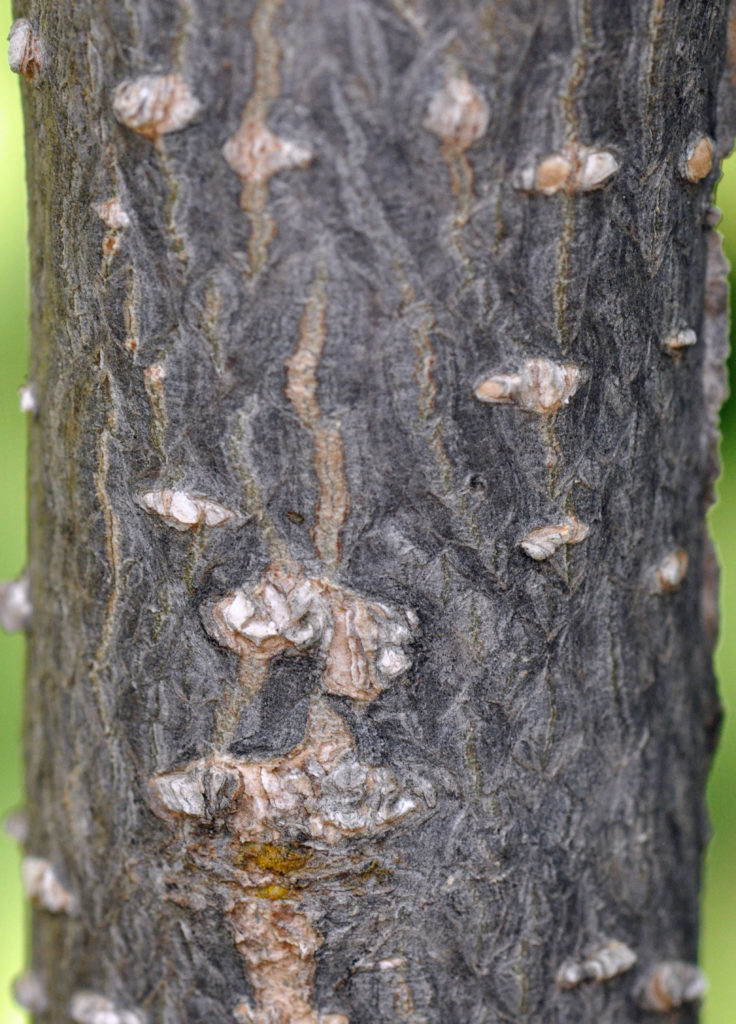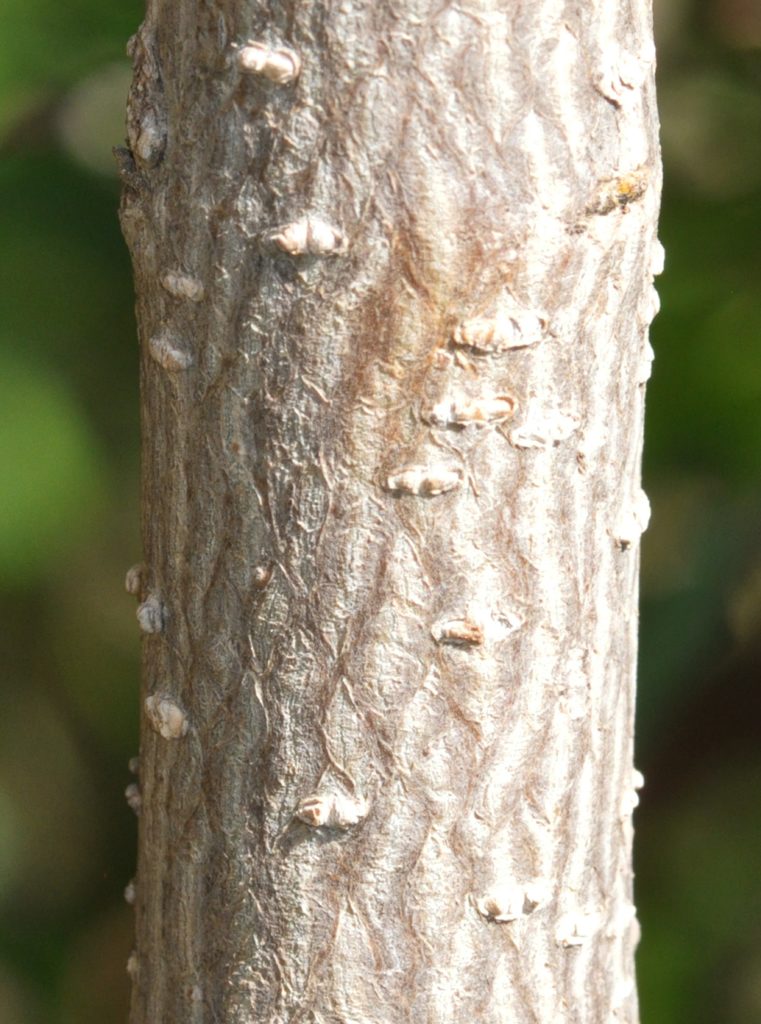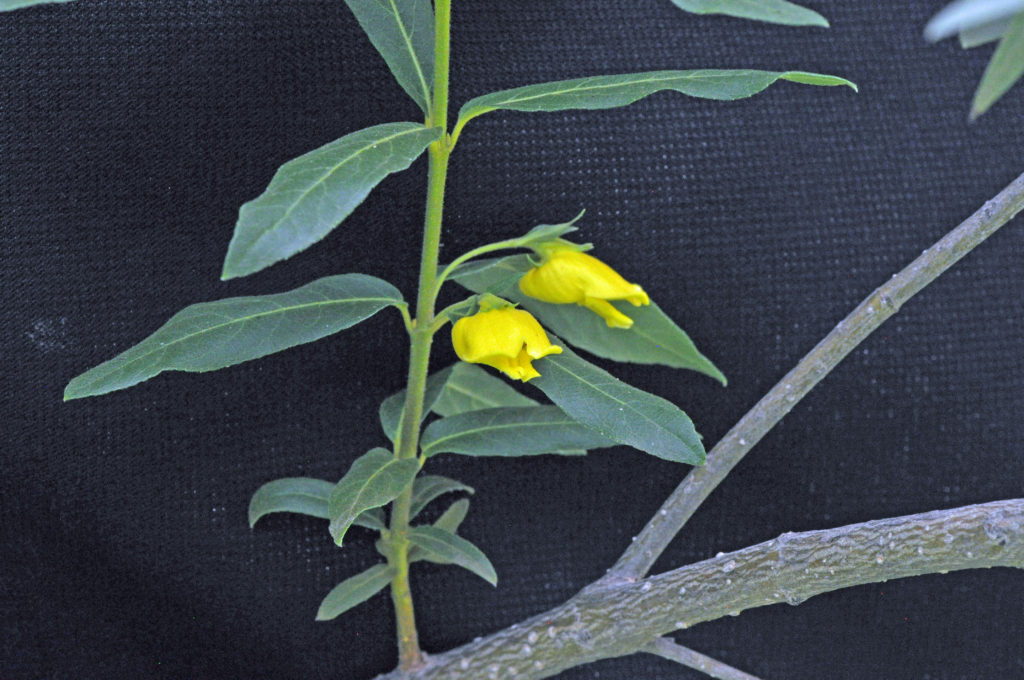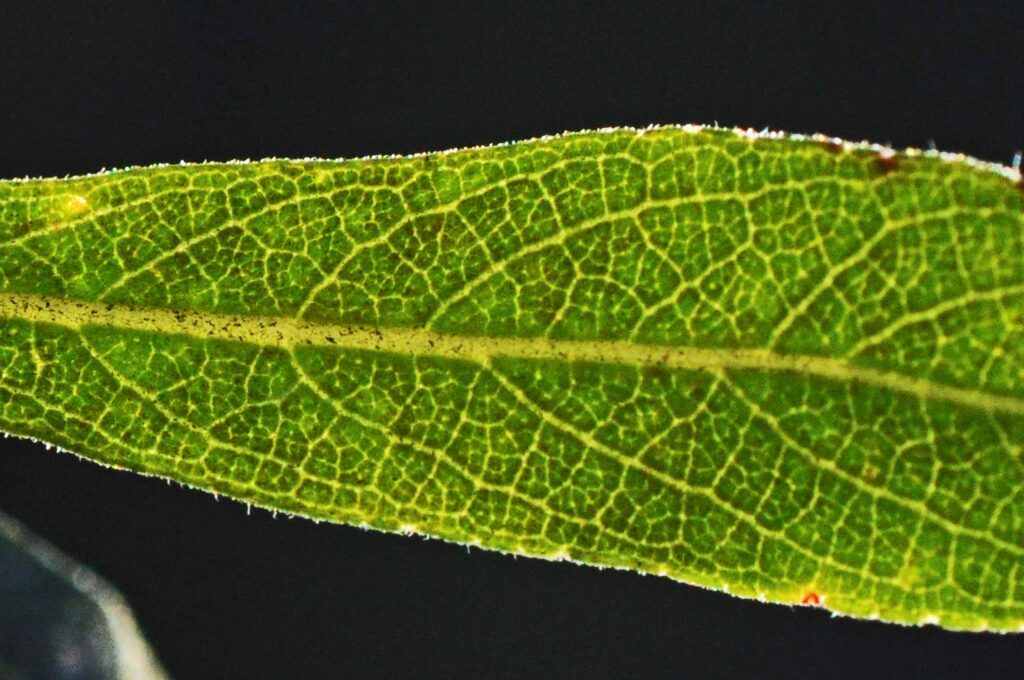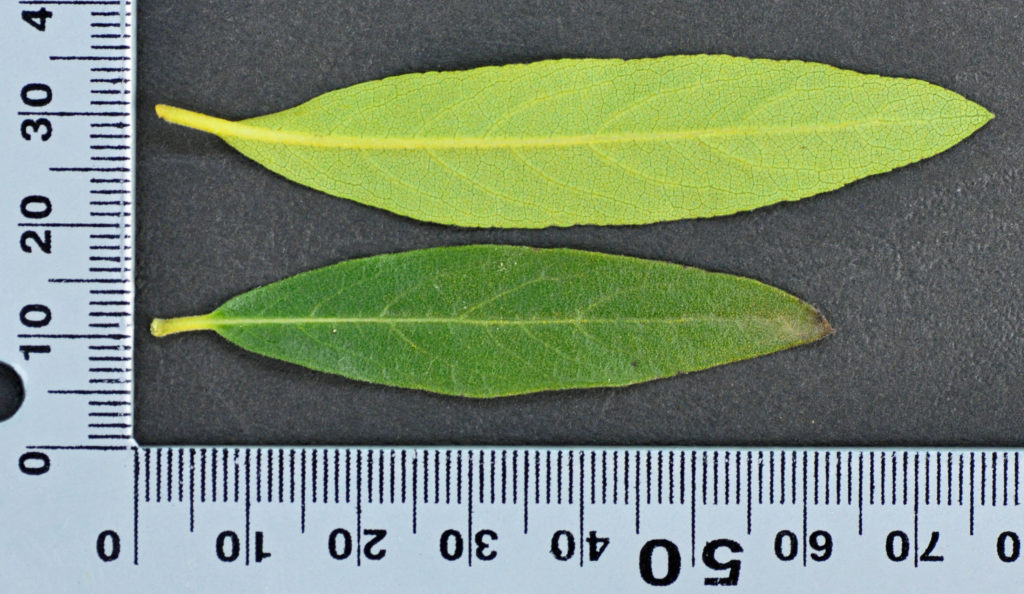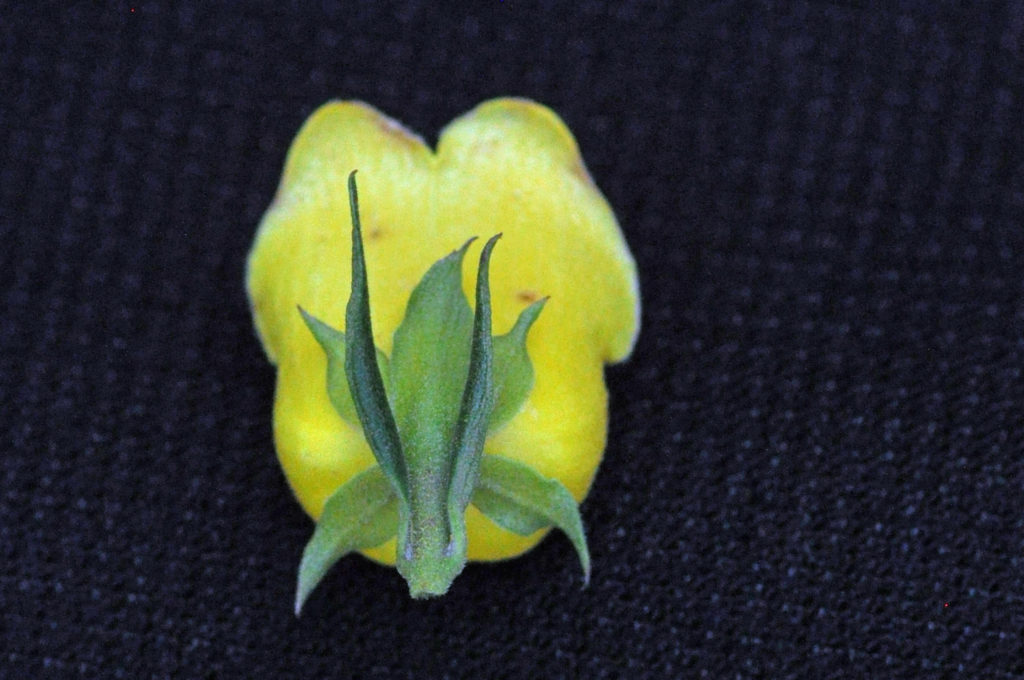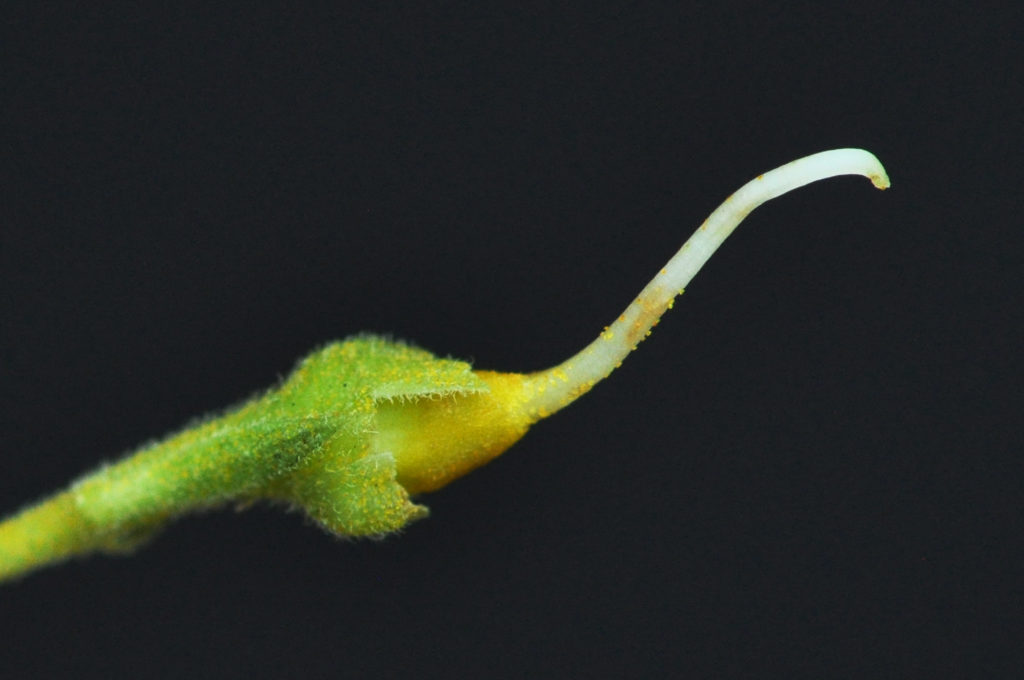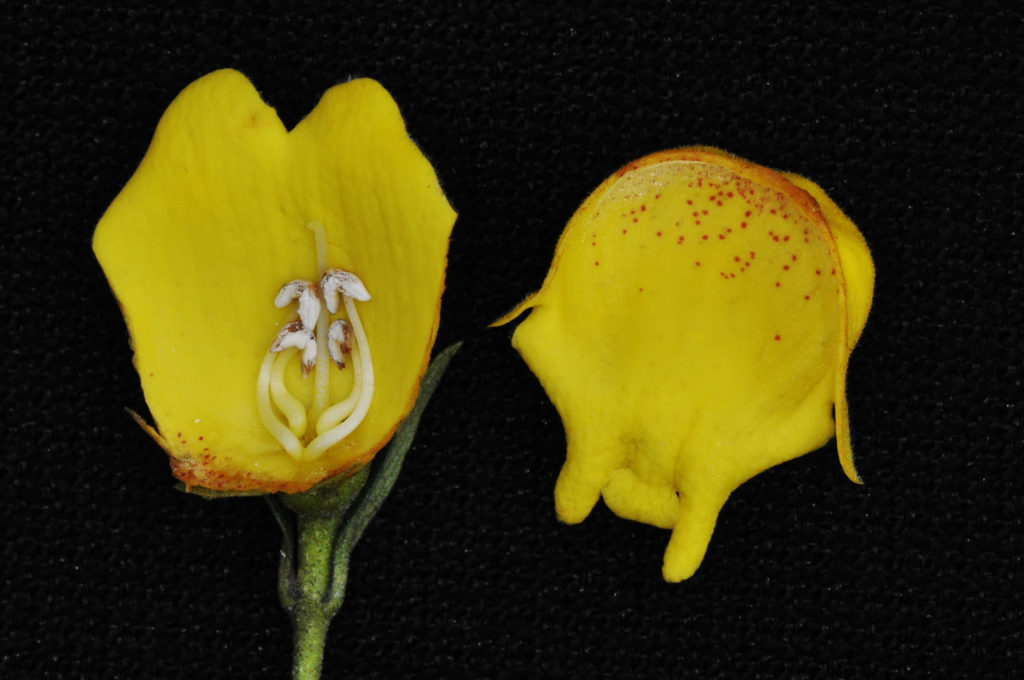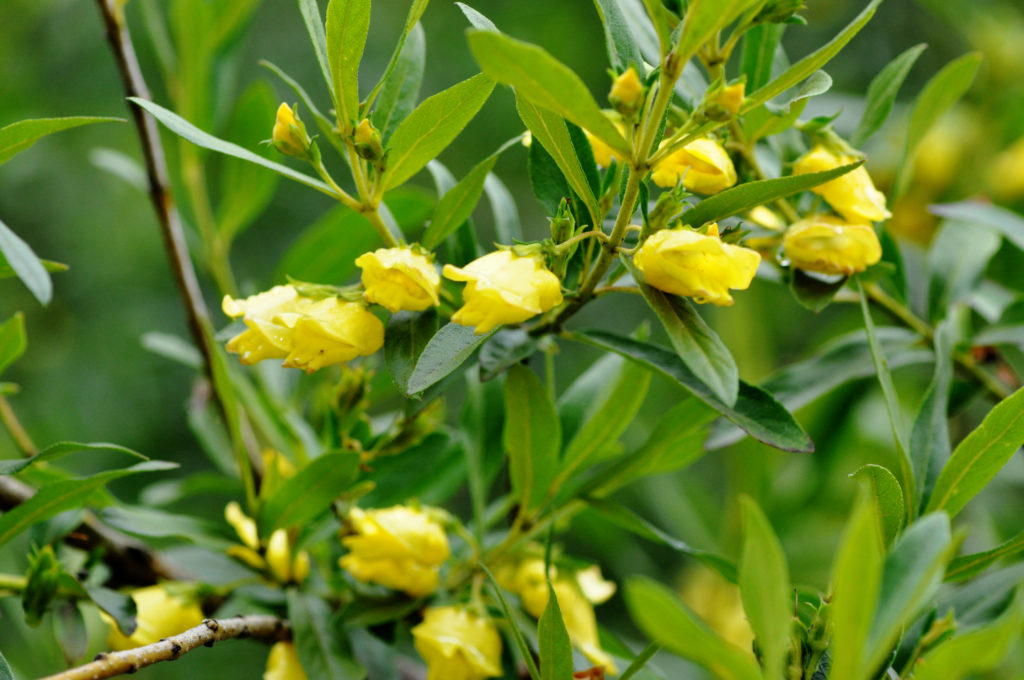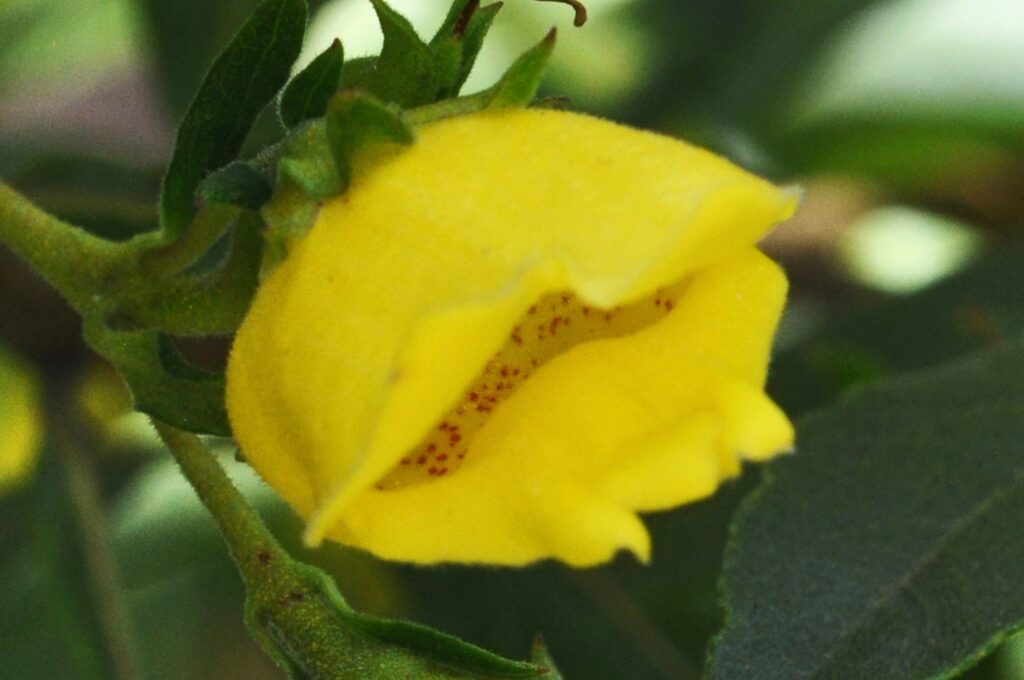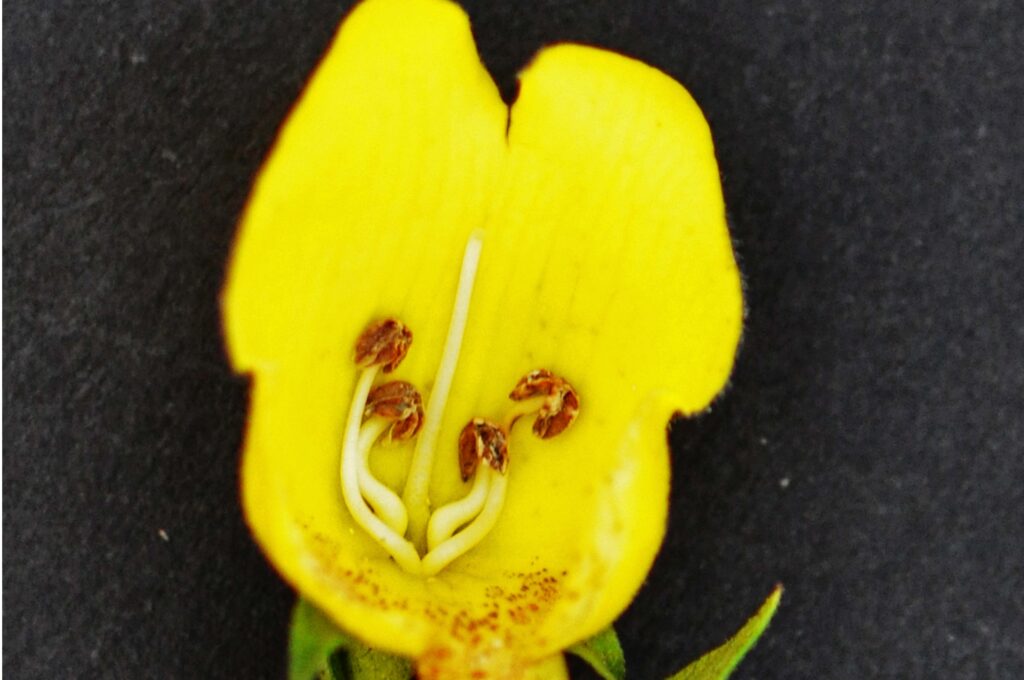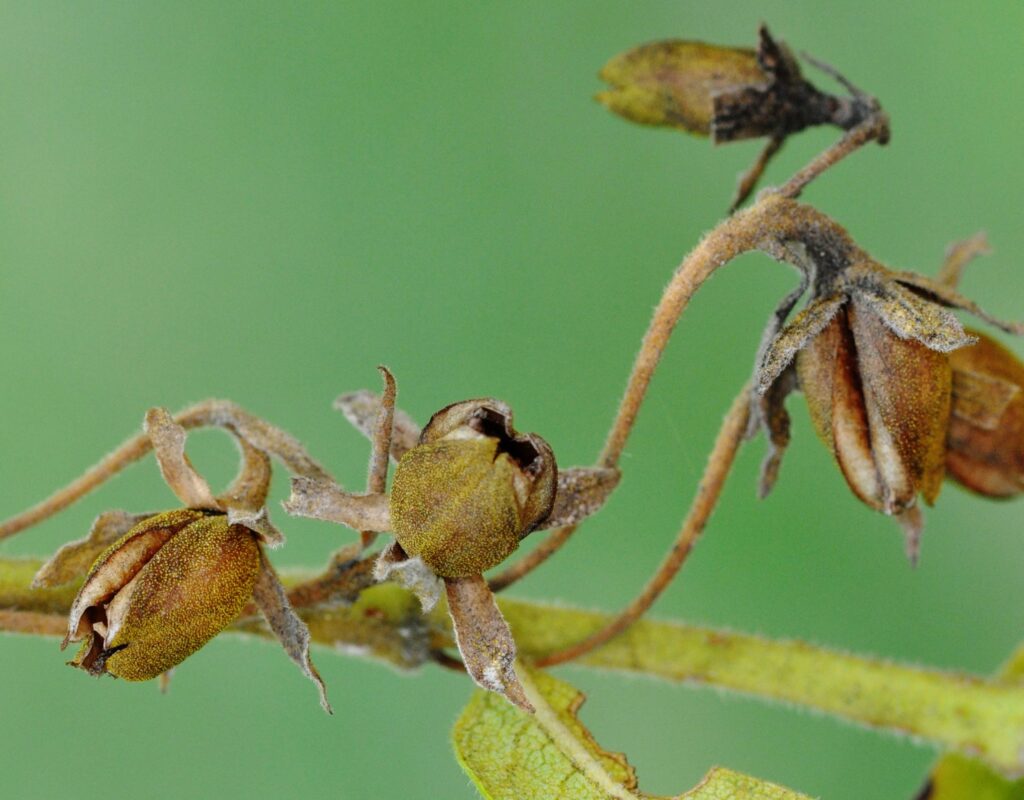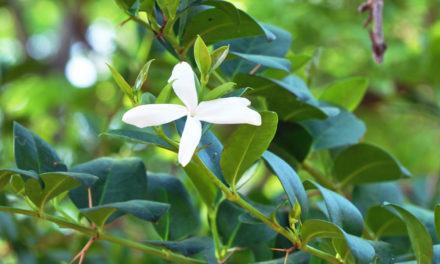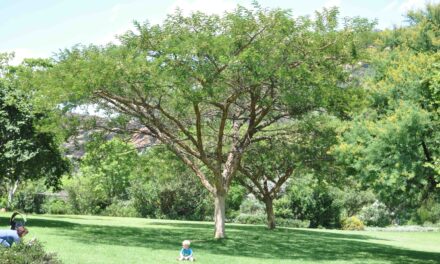Bowkeria citrina
General Info – summary
This 3m high, Tree is often a multi-stemmed shrub. Simple aromatic Leaves lack stipules, are elliptic to lanceolate & occur in whorls of up to 4. Margins may be narrowly scalloped. Bisexual, zygomorphic, bracteate, oil producing Flowers have bilabiate, joined yellow petals, attached didynamous stamens and 1 staminode. Pistil has one style & a superior ovary. Fruit a small 2-lobed woody capsule with many seeds
Description
Previous Names: Nil.
SA Tree No. 672.1
Common names: (Afr) Geelskulpblombos. (Eng) Yellow Shell-flower.
Family: Stilbaceae: (Family with 6 genera and about 14 species). Local genera on this website include Anastrabe, Bowkeria, Halleria, and Nuxia. Members of this family have simple and entire Leaves that lack stipules and have recurved margins. Non-stellate hairs are present. Flowers are bisexual and zygomorphic or regular and the corolla is funnel-shaped and usually 2-lipped. The usually 4 Stamens are epipetalous (born on or arising from the petals), and the usually superior Ovary initially has 2 locules each with 1 ovule. Fruit is usually a dehiscent capsule but may be a berry.
Name derivation: Bowkeria – named after two naturalists Col. H. Bowker (1826-1900) – and his sister M. S. Barber who was a botanist. He was better known as an Entomologist and Botanist. He was also the co-author with Roland Trimen of a book on ‘South African Butterflies’. The entire genus Bowkeria has 3 species) is endemic in Southern Africa. The other 2 species are B. cymosa (the tallest Bowkeria) and B. verticilata (both are mountainous species). citrina – lemon yellow – referring to the flowers.
Conservation: National Status: Rare but not threatened. Assessed: 2005/09/15. (K.E. Steiner and K. Naidoo). This plant has a very restricted natural range.
Tree
The Tree may reach 3m high, but it is usually a multi-stemmed aromatic shrub with sessile glands on many parts. The Bark is often dark grey (photos 629 & 590 under Leaves) to greyish white (photo 544). In addition, there are small light coloured and distinctly raised lenticels (usually raised corky oval or elongated areas on the plant that allow the uncontrolled interchange of gases with the environment – photos 629, 544 & 590 under Leaves). Fine soft golden Hairs are present on young branches.
- 176. 2014/12/02. Walter Sisulu NBG. Photo: David Becking.
- 629. 2015/04/14. Walter Sisulu NBG. Photo: David Becking.
- 544. 2014/10/28. Walter Sisulu NBG. Photo: David Becking.
Leaves
The soft, slightly leathery Leaves occur in whorls of 3 or 4 (photo 590) or they are occasionally opposite (photo 590). They are narrowly elliptic to lanceolate and up to 8 x 1cm (photo 540). All leaves are simple (have a single blade which may have incisions that are not deep enough to divide the leaf into leaflets). The Margin is hairy (photo 118) and narrowly scalloped (photo 540) – especially in young plants. It may also be entire (with a continuous margin, not in any way indented). The Blade may have fine hairs of different intensity. The Upper surface is a dull olive green with a sunken midrib. The Lower surface is much lighter and has a clearly visible yellow protruding midrib (photo 540). The midrib and lateral veins are yellowish and tend to arch along the margin prior to reaching it (photo 118). All veins are best viewed when the leaf is held against the sun (photo 118). The Apex tapers to a point. The Base also tapers – slightly less so. The Petiole (leaf stalk) is greenish yellow, hairy and up to 7mm long (photo 540). Stipules (basal appendages of the petiole) are absent. Leaves have a pleasantly lemony aromatic flavour when crushed. This is the only species in the genus Bowkeria with this diagnostic characteristic.
- 590. 2015/10/20. Walter Sisulu NBG. Photo: David Becking.
- 118. 2016/05/31. Walter Sisulu NBG. Photo: David Becking.
- 540. 2014/10/28. Walter Sisulu NBG. Photo: David Becking.
Flowers
The attractive Flowers are bisexual, axillary (in the axil – growing between stem and leaf) and solitary (photo 453). Usually 1 but up to 3 flowers develop in leaf axils. The up to 2 x 2cm flowers are zygomorphic (irregular flower with the corolla divisible into 2 equal halves in one plane only). Flowers are bracteate (bearing Bracts – modified specialised leaves usually found with inflorescences and flowers). Here there are 2 darker green lanceolate subtending bracts below each flower (photo 822). The 5-lobed, hairy (photo 293) Calyx has longish different sized Sepals (largest above) with overlapping edges (photo 822). Here 3 sepals point forwards (largest in the centre) and two backwards. The Corolla is removable as a single piece. The corolla has Petals that are joined to form a bell-shaped tube with many attractive small red marks near the interior base. The marks are more clearly visible if the tube is opened (photo 807). These attractive, bright yellow, bilabiate (2-lipped) flowers are scuttle-shaped (photo 168). The yellow colour is unique for this genus. The other species all have white flowers. The Upper lip is 2-lobed, and the Lower lip is 3 lobed. The 4 Stamens are not exserted (do not stick out beyond the mouth of the petals) and are didynamous (having 4 stamens disposed in 2 pairs of 2 different lengths – photo 686). Each pair has stamens of equal length but a different length from the other pair. The anterior pair are basally twisted so all anthers face outwards (photo 686). A single staminode (sterile stamen) is present. There is a single Pistil (a unit of the Gynoecium, the female element of the flower, composed of the Ovary, Style and Stigma). The superior usually bilocular Ovary contains many ovules and has a long single Style which extends after the anthers have developed (visible in photos 686 & 293). (Usually: Jan- Mar).
- 822. 2016/11/29. Walter Sisulu NBG. Photo: David Becking.
- 293. 2018/01/11. Walter Sisulu NBG. Photo: David Becking.
- 807. 2017/02/07. Walter Sisulu NBG. Photo: David Becking.
- 453M. 2014/12/09. Walter Sisulu NBG. Photo: David Becking.
- 168. 2014/12/02. Walter Sisulu NBG. Photo: David Becking.
- 686. 2014/12/23. Walter Sisulu NBG. Photo: David Becking.
Fruit
The eventually brown, ovoid, slightly woody Fruit is a small – about 10 x 5 mm Capsule (a dry fruit resulting from the maturing of a compound ovary, which usually opens at maturity by one or more lines of dehiscence). Here it splits into 2 valves (separable part of a pod) and the line of dehiscence lies between the carpels (carpel – female flower part containing a stigma, style (usually), ovary & ovule/s). The carpel is an organ (generally believed to be a modified foliar unit – related to leaves) at the centre of a flower, bearing one or more ovules and having its margins fused together or fused with other carpels to enclose the ovules in an ovary. The now open Calyx (photo 301) remains attached to the base of the capsule (photo 301) which splits into 2 valves. Fruit and flowers often develop at the same time. Many very small ellipsoid Seeds are produced. (Feb-Jul).
The eventually brown, ovoid, slightly woody Fruit is a small – about 10 x 5 mm Capsule (a dry fruit resulting from the maturing of a compound ovary, which usually opens at maturity by one or more lines of dehiscence). Here it splits into 2 valves (separable part of a pod) and the line of dehiscence lies between the carpels (female flower parts containing a stigma, style (usually), ovary & ovule/s). The carpel is an organ (generally believed to be a modified foliar unit – related to leaves) at the centre of a flower, bearing one or more ovules and having its margins fused together or fused with other carpels to enclose the ovules in an ovary. The now open Calyx (photo 301) remains attached to the base of the capsule (photo 301) which splits into 2 valves. Fruit and flowers often develop at the same time. Many very small ellipsoid Seeds are produced. (Feb-Jul).
- 301. 2016/09/15. Walter Sisulu NBG. Photo: David Becking.
Distribution & Ecology
This range restricted plant is Endemic (Endemism is the ecological state of a species being unique to a defined geographic location) in South Africa. Here there are 5 natural populations. Bowkeria citrina is naturally located in North-West KwaZulu-Natal, and southern Mpumalanga in moist highland grasslands. Plants occur on forest margins, stream banks, below rocky hillsides-including cliff edges, margins of evergreen forests and has an altitude range of 1 400 – 1 800m. This plant secrets non-volatile oil that attracts female oil collecting bees in the genus Rediviva. The oil is collected deep within the flowers by the extra-long front legs of the female bee and fed to bee-larvae. In the process the female bee aids with pollination. “Ordinary” bees are also involved in the nectar collection and in pollination.
Ethnobotany
These slow growing plants do best if planted in the open – in moist areas. Although the plant is not frost sensitive, it will not survive a prolonged dry period. Cuttings are the best means of propagation.
References
Boon, R. 2010. Pooley’s Trees of eastern South Africa. Flora and Fauna Publications Trust, Durban.
Coates Palgrave, M. 2002. Keith Coates Palgrave Trees of Southern Africa, edn 3. Struik, Cape Town.
Lawrence, G. H. M, 1951. Taxonomy of Vascular Plants. The Macmillan Company, New York. Tenth Printing 1965.
Palmer, E. & Pitman, N. 1972. Trees of southern Africa. Balkema, Amsterdam, Cape Town.
Schmidt, S. Lotter, M. & McCleland, W. 2002. Trees and Shrubs of Mpumalanga and the Kruger National Park. Jacana, Johannesburg.
Steiner, K.E. & Naidoo, K. 2005. Bowkeria citrina Thode. National Assessment: Red List of South African Plants version . Accessed on 2025/02/01.
van Wyk, B. & van Wyk, P. 1997 Field guide to Trees of Southern Africa. Struik, Cape Town.
https://en.wikipedia.org/wiki/Bowkeria
http://www.plantzafrica.com/plantab/bowkercit.htm
http://www.biodiversityexplorer.org/plants/stilbaceae/index.htm
http://pza.sanbi.org/bowkeria-citrina
http://posa.sanbi.org/flora/browse.php?src=SP
http://www.biodiversityexplorer.org/people/trimen1.htm
http://showme.co.za/durban/tourism/colonel-james-henry-bowkers-monument-in-malvern/
http://www.theplantlist.org/1.1/browse/A/Stilbaceae/

